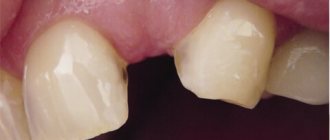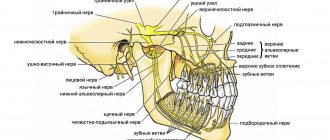Tooth enamel is a protective shell that covers each tooth individually to protect it from various types of damage. Despite the high strength of tooth enamel, it can be destroyed due to mechanical, temperature, bacterial and chemical damage. High-quality oral care will ensure healthy teeth for many years. This article will discuss effective ways to restore tooth enamel at home and using professional methods.
- Remineralization
Features of treatment of anterior teeth
The four incisors in the center of the upper and lower jaws are the front teeth. They are capricious, with a thin layer of enamel and dentin, caries strikes them quickly. Therefore, at the slightest discomfort, run to the dentist!
The front teeth are a very important area not only for the patient, but also for the dentist. They are always visible; everyone will notice errors in treatment. Incisors require jewelry precision from the dentist; the enamel is thinner, so the patient experiences more pain. Don’t forget about aesthetics - an incorrectly chosen filling color or poor degree of transparency will ruin the entire treatment.
The smile area requires special care. Observation should be made for crowded front teeth that overlap each other and are too large. The lack of vitamins in the body primarily affects the incisors - vitamin deficiency does not cost anything to undermine the already thin enamel. Food that often gets stuck in the interdental spaces warns of impending caries. It is better not to delay your visit to the clinic where front teeth are treated in Moscow: at the very beginning, caries is treated without the use of a drill.
Restoration methods for the initial stage of destruction
Restoration of tooth enamel is the implementation of measures aimed at reconstructing the appearance of the enamel layer and restoring the protective functions it performs.
It is performed using various methods depending on the condition of the enamel. The earlier measures are taken, the better the effect. When initial symptoms appear, the following measures are effective:
- professional hardware teeth cleaning;
- remineralization – saturation of enamel with essential minerals, including fluoridation (coating teeth with a special varnish).
Note: it is impossible to restore enamel at home. The patient can only help the doctor. To do this, he must review his diet, carefully carry out hygienic dental care, eradicate bad habits, and begin treating systemic diseases (if any).
Treatment methods – from filling to implant
The dentist will select the treatment method for the front teeth after an examination.
- Veneers or Lumineers
If the incisors are severely damaged, thin overlays can be placed - veneers or lumineers. They will hide the consequences of caries and make teeth whiter and smoother.
- Dental crowns
If only the root remains of the front tooth, intra-root inlays are made; this is the basis for the crown. Metal crowns are not suitable for front teeth; they will be too noticeable. To make an artificial tooth as similar as possible to a real one, it is better to use ceramic and zirconium crowns.
- Bridges and implants
If desired, missing front teeth can be replaced by bridges and clasp dentures. If funds allow, you can install an implant and forget about the problem for many years.
Example 9. Restoring the bottom six “from the root”
In this case, I would like to simply dwell on the moment of restoration itself. The patient is older, over 50 years old. And he felt the need to restore the chewing group of teeth. The picture shows the lower 6th tooth, of which practically only one root remains:
The tooth was restored in 1.5 hours
using Cerec technology. The very speed of tooth restoration in one visit to the doctor and the patient’s ability to immediately, as they say, use it in chewing gives a 100% head start on any existing method of tooth restoration. It works really well - you can see for yourself.
Example 10. Restoring the bottom seven
And I end my examples with the classic option of restoring the seventh lower tooth, of which only the root part remains. Removal of the lower 7th root of the tooth was not required; Cerec technology again proved to be excellent:
After modeling in 3D, manufacturing the module itself only took about 20 minutes, after which it was successfully installed on the remaining root:
Treatment of caries of anterior teeth
The main method of treating caries in the front teeth is filling. When it comes to incisors, in the language of dentists this is called very beautifully - artistic restoration. It is better not to save on the cost of the filling. High-quality material will last longer and will not spoil your smile. The front teeth are always visible, so the dentist has to select the color and degree of transparency of the filling with pinpoint precision; it must match the shade of the tooth as closely as possible. Reflective composite materials do not spoil the aesthetic appearance. Over time, light fillings do not darken or wear off.
Why removing the root is not the solution to the problem
If there is no natural crown, and instead of it an empty space appears, especially when it is the roots of the upper front teeth, many people habitually rush to the surgeon. They want to remove the remains and quickly install a bridge, eliminating the aesthetic defect.
But first, it’s worth considering the situation with your doctor - there are certain risks during removal: damage to the mandibular nerve, excessive trauma to the gums, and others. In addition, tooth restoration based on its own root is always more gentle than any prosthetic method.
Dentists try to preserve every unit, since the absence of natural teeth leads to a decrease in the quality of life. If you simply remove the roots of permanent teeth, then immediate implantation is needed. In the absence of a unit, destructive processes begin in tissues, and bone volume decreases. Therefore, doctors do not recommend neglecting this problem. Even if there is no chewing molar, which is not visible.
Crack on front tooth
The front teeth always get the most damage. When they “punch you in the teeth,” the blow usually falls on them. They fell unsuccessfully, worried, chewed a pencil, or, horror of horrors, chopped nuts with their incisors, and now a crack appeared on the front tooth. By the way, it can occur without mechanical damage - for example, due to temperature changes. Teeth don't really like iced coffee. You shouldn’t overuse citrus fruits or their juices either, and it’s best to dilute freshly squeezed juices with water to reduce their acidity. You should not get carried away with whitening procedures, and be more careful with abrasive pastes. Cracks are also different.
Vertical
If you are “lucky” and it is small vertical, then nothing bad will happen to this tooth, and the defect will be barely noticeable. In this case, many dentists do not recommend loading the tooth with patches. But you still need to keep an eye on the crack. If it increases, the enamel changes color, and the tooth reacts sharply to hot/cold, sweet/salty, you should consult a dentist. The enamel will need to be restored and strengthened. The crack will be treated with a special compound containing calcium and fluorine. After the course of treatment, the tooth will react normally to food and become more even and smooth.
Horizontal
But horizontal or oblique cracks in the front teeth are a cause for serious concern. They provoke the formation of caries, chips and can generally lead to tooth loss. Treatment depends on the size, depth and location of the crack, as well as the characteristics of the enamel. If there are many microcracks on the tooth and the color of the enamel has changed, the doctor may suggest installing veneers, but only after treating caries and other oral diseases. A crack left unattended will permanently split the tooth. Then there will only be one treatment option left - prosthetics.
What to do with a thin protective shell
In case of damage or genetic predisposition, there is no need to be upset. We will have to strengthen control and care of the oral cavity in order to prevent the development of pathological processes and long-term treatment, but there is nothing terrible about it. Follow a few basic principles that will help keep your smile beautiful and your teeth healthy:
- stop eating solid foods;
- visit the dentist at least once every six months;
- carry out professional fluoridation;
- use remineralizing agents twice a day as prescribed by your doctor;
- stick to a diet, eat more vegetables, fruits and healthy foods.
To prolong the beauty of a smile, it is enough to increase attention and care. This will not take much time, but will prevent further tooth thinning and damage.
Loose front teeth
Loose front teeth are a wake-up call. Often this trouble happens with the front teeth. The main cause of looseness is gum disease: periodontal disease, stomatitis, gingivitis. You should not run them, otherwise you may end up without teeth at all.
The doctor will select the treatment for loose teeth individually. If the swaying is accompanied by pain, the teeth deviate significantly to the sides, the dentist applies special splints, removable or non-removable, to the incisors. Splinting strengthens mobile teeth, prevents their loss, and allows periodontal tissues to recover. In severe cases, surgical treatment cannot be avoided. During surgery, the surgeon removes bone tissue or restores it using metal shunts.
Cysts in the tooth canal and granuloma have a bad effect on the roots, and the teeth begin to become loose. These tumors need to be removed. If the tooth begins to loosen after a blow or injury, it is better to go for an x-ray.
If your front tooth hurts after treatment
Patients often complain that their front teeth hurt after treatment. The dentist cleaned the canals, so this is normal. The discomfort should go away within a few hours. But if the treatment is done poorly, the tooth may hurt for a long time - and this is already a deviation from the norm. Most likely, the doctor made a mistake during treatment and the entire filling process will have to be repeated. The cause of pain can be a burn of the pulp, damage to the enamel, an allergy to medications, or acid contact with dentin.
How much does front tooth treatment cost?
The cost of treatment depends on the method and materials used. When it comes to the smile area, it is better not to skimp. In this case, prudent patients often have to remember the stingy man who pays twice. Choosing cheap materials often leads to aesthetic flaws, disappointment and repeated treatments.
As a rule, prices for treatment of front teeth in Moscow start from 2,000 rubles. For example, the cost of caries treatment without drilling ranges from 2,000 to 5,500 rubles. A light seal costs from 1,500 to 10,000 rubles. The price tag for splinting loose front teeth starts from 2,800 to 7,000 rubles. Removing a cyst will cost 7,000 - 37,000 rubles, granulomas - from 5,000 to 40,000. A dental inlay will cost from 5,200 to 20,000 rubles. Prices for veneers start from 5,000 rubles, lumineers - from 40,000. The range of prices for zirconium crowns is from 13,500 to 40,000, ceramic - from 17,000 to 57,000. Clasp prosthesis will cost from 29,000 to 73,000, dental implantation - from 30,000 to 120,000 and more.











